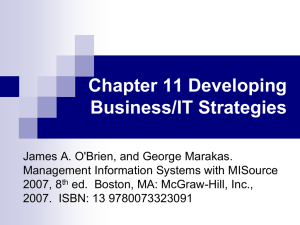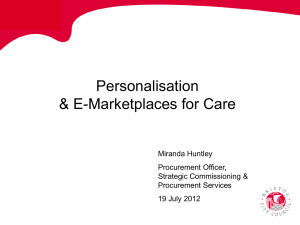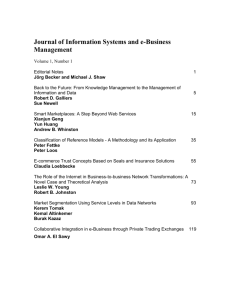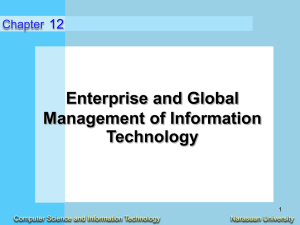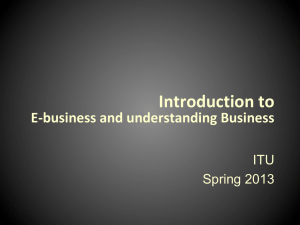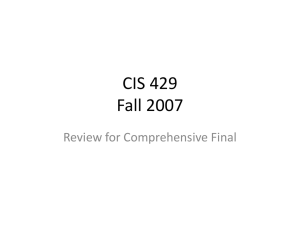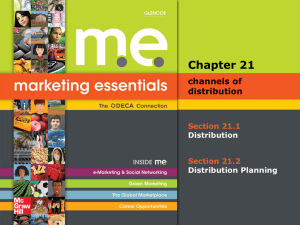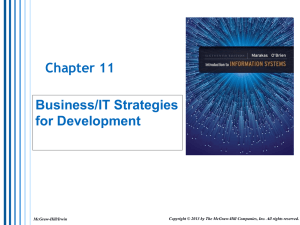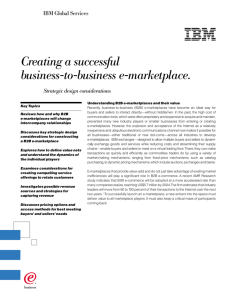Integration of research and practice for teaching of e
advertisement
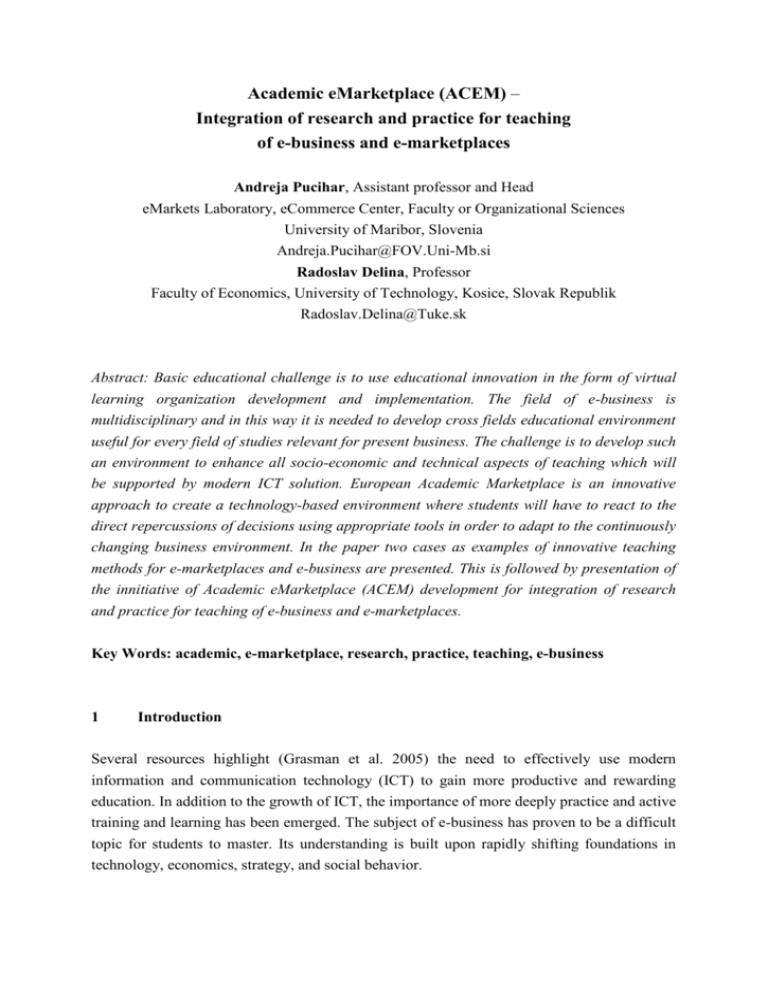
Academic eMarketplace (ACEM) – Integration of research and practice for teaching of e-business and e-marketplaces Andreja Pucihar, Assistant professor and Head eMarkets Laboratory, eCommerce Center, Faculty or Organizational Sciences University of Maribor, Slovenia Andreja.Pucihar@FOV.Uni-Mb.si Radoslav Delina, Professor Faculty of Economics, University of Technology, Kosice, Slovak Republik Radoslav.Delina@Tuke.sk Abstract: Basic educational challenge is to use educational innovation in the form of virtual learning organization development and implementation. The field of e-business is multidisciplinary and in this way it is needed to develop cross fields educational environment useful for every field of studies relevant for present business. The challenge is to develop such an environment to enhance all socio-economic and technical aspects of teaching which will be supported by modern ICT solution. European Academic Marketplace is an innovative approach to create a technology-based environment where students will have to react to the direct repercussions of decisions using appropriate tools in order to adapt to the continuously changing business environment. In the paper two cases as examples of innovative teaching methods for e-marketplaces and e-business are presented. This is followed by presentation of the innitiative of Academic eMarketplace (ACEM) development for integration of research and practice for teaching of e-business and e-marketplaces. Key Words: academic, e-marketplace, research, practice, teaching, e-business 1 Introduction Several resources highlight (Grasman et al. 2005) the need to effectively use modern information and communication technology (ICT) to gain more productive and rewarding education. In addition to the growth of ICT, the importance of more deeply practice and active training and learning has been emerged. The subject of e-business has proven to be a difficult topic for students to master. Its understanding is built upon rapidly shifting foundations in technology, economics, strategy, and social behavior. Textbooks on the topics are often dated with examples that no longer illustrate intended lessons or present trends (Wheeler 2000). Its inter-disciplinary nature allows improving knowledge and skills in some narrow part of e-business (e.g., consumer marketing, supply chain management, e-sourcing, information technology management, etc.). Given the shifting foundations of the e-business topics and the immense effects of digital networks on commerce, the real educational need is for students to learn how to assimilate and interpret e-business opportunities and trends and use most effective trading tools and solutions for supply chain management. Traditional course pedagogy of lectures, cases, and exercises are well-suited to conveying factual bodies of knowledge or sharpening thinking skills within bounded domains. The ebusiness course needs a structure that could enable and motivate the students to engage with a world of e-business phenomena and to assimilate that into coherent meaning. It has to be experiential and purposeful for the students. The challenge is to develop such an environment to enhance all socio-economic and technical aspects of teaching which will be supported by modern ICT solution. Further in the paper two cases as examples of innovative teaching methods for eMarketplaces and e-business are presented. This is followed by presentation of the innitiative of Academic eMarketplace (ACEM) development for integration of research and practice for teaching of ebusiness and e-marketplaces. 2 Existing teaching cases as approaches to improve education in e-business 2.1 Case of eCommerce Course at the University of Maribor The detail description of e-Commerce course at the Faculty of Organizational Sciences at the University of Maribor is available in The European e-business report: a portrait of e-business in 10 sectors of the EU economy (Gričar et al 2004) and in Special issue of the Journal of Information Systems Education on E-Commerce Education (forthcoming in April 2005) (Gričar et al 2005). In the e-Commerce course at the Faculty of Organizational Sciences at the University of Maribor in Slovenia a group of three students choose two project sponsors – existing business partners, one being a buyer, the other being a seller. The organization may be a large or small business company or government agency. In each organization, a project sponsor (problem owner) and a technologist (information specialist) are identified. By agreeing to work with students, the two entities explore possibilities that will make the business more competitive. With this foundation, the course is run in traditional setting, consisting of groupwork, visits to the organizations, and student presentations in organizations with class discussions, prototype development with a class presentation before the presentation to the organization. Students submit a formal student project proposal that includes the project sponsor’s name and position in organizations, problem description, process analysis and project goals. All proposals are reviewed and approved by the faculty. In the eCommerce Course students explore available e-marketplaces by using the eMarketServices portal (www.emarketservices.com). The eMarketServices portal provides free information with a general overview of e-marketplaces, case studies and reports from various industries, key factors needed to be considered for selecting the e-Marketplace and a global directory of almost 900 e-marketplaces - sorted by industry and geographical focus. Students also explore the Iskraemeco case study (Pucihar and Pecarz, 2004) that describes use of e-marketplaces from the Slovene perspective. Students use the eMarketServices portal to gain information about e-marketplaces for the selected project. Based on organization's expectations, the environment and type of business process, the students identify three emarketplaces from eMarketServices directory that are applicable for each of the two organizations. From these three, they propose the most suitable e-marketplace to the project sales and procurement executive. Students use e-commerce technology for e-marketplace development during the course in computer lab exercises. In 2002, the local Oracle Branch Office approved Oracle Exchange, a hosted application, for student use. Students also use a web browser to access a preproduction version of Oracle Exchange e-marketplace that is intended for training Oracle professionals. This allows students to explore and to present e-marketplace services for a variety of business scenarios. Some examples are: e-auctions (buyer’s and seller’s), RFQs, eCatalogue trading. Oracle Exchange is used as a hosted solution in Oracle’s Austin Datacenter in the USA. There is no server administration or software installation needed by the faculty. Server eCommerce Center Faculty of Organizational Sciences from University of Maribor joined the eMarketServices project as the Slovenian National Contact Point for dissemination project results. Beginning in January 2004, eMarketServices received co-funding from the European Commission/DG Enterprise. The aim is to make it easier for companies in Europe, and around the world, to use e-marketplaces for international business. This role as an official European portal strengthens eMarketServices’ as a leading international source for information on B2B e-marketplaces (www.eMarketServices.com). administration and software upgrades are made by Oracle professionals. Faculty prepare written a user guide and also coaches students using Oracle Exchange e-marketplace in the computer lab. Since the web browser user interface is easy to use, there is no major difficulty in using the program. This enables students to focus on business processes that could be performed in the e-marketplace and not being concerned with the technology. Students develop a prototype e-solution in order to demonstrate a trading process on an e-marketplace for the selected organizations. Oracle Exchange e-marketplace allows students to develop a prototype that provides a practical insight into specific trading scenarios. The organization’s products or services (name, code, description) and basic trading conditions (price, quantity, and costs) are used to develop a realistic scenario. Students do not utilize the order fulfillment process. Since e-marketplace services and trading mechanisms are not dependant on a particular technology, the use of Oracle Exchange e-marketplace enables students and organizations to explore almost any service that is available in a typical e-marketplace. Students present the prototype solution to both organizations, preferably at a joint meeting of the representatives of both organizations. They collect written feedback about the prototype from the representatives. Most successful e-marketplace prototypes are promoted in a student bazaar session at the annual Bled eCommerce Conference (Pucihar et al., 2002; Pucihar et al., 2003; Pucihar et al., 2004) and the annual Merkur Day - Undergraduate and Graduate Students eCommerce Conference (Jordan 2003). Students participate in an e-readiness assessment of the two organizations where the project will be run. Based on suggestions developed by the eBSN (European eBusiness Support Network) for SMEs, a questionnaire was developed and used in Slovenian organizations for the first time during the 2003-04 academic years. The questionnaire contains questions about eBusiness indicators that are published in annual eBusiness W@tch reports. Questionnaire results show the organization’s e commerce readiness. 2.2 Case of University of Missouri The University of Missouri Virtual Enterprise (UMVE) facilitates a central virtual enterprise that emulates a real-world business environment and the complexities of a modern enterprise that integrates a variety of business processes. The UMVE creates a dynamic computer simulated environment utilizing available information technology that provides students with a hands-on and active learning experience. Academic classes, as well as businesses, play roles of various supply chain entities. Actions taken by one entity influence the decisions made by the other entities in the virtual enterprise, thus accurately emulating the dynamic nature of remotely located, yet coordinated, components of a virtual enterprise. For example, consider the following scenario (Grasman et al 2005): A new system specified by a marketing class could be designed by Engineering Design students. The system would then be produced in an assembly cell operated by Manufacturing Engineering students, and Operations Management students would work with process planners to develop required policies. Accounting/Finance and Management students would participate in developing a business justification and planning and control mechanisms with usage of knowledge management, esp. data mining. They can learn how new techniques of knowledge management as knowledge discovery or simulations tools can help to make a better decisions. Marketing students would be involved in developing a business and advertising/marketing plan. Information Systems and Accounting students would be involved in designing appropriate decision support and reporting systems to facilitate informed decision-making by the various functions. Students from MBA can study and develop different strategies according to procurement scenarios. Computer Science and Computer Engineering students would be involved at several levels by developing computer applications and interfaces to support communications, control systems, data sharing and other integration needs (Grasman et al 2005). This innovative approach creates a technology-based environment where students must react to the direct repercussions of decisions using appropriate tools in order to adapt to the continuously changing world (Grasman et al 2005). Further, this approach allows for the creation of (1) a teaching environment that both encourages and supports the on-going use of the student marketplace for teaching and decision-making, (2) a set of role-based, pedagogical materials for use in introductory, core, and advanced classes for undergraduate, graduate, and executive education in business, information systems, and engineering, and (3) a data warehouse of simulated, “real-world” information over a series of years that can be used to stimulate research and the development of new ideas. The UMVE provides a unique opportunity for innovative and integrated curricula that address both technical and managerial skills and combines engineering with key elements of business management (Grasman et al 2005). The hands-on and active learning environment provides the culmination of transforming curricula where classes are taught in isolation into a multidisciplinary integrated environment (Figure 1), thus introducing students to all aspects of enterprise engineering and illustrating the need for integrative and dynamic curricula based on real-world scenarios. These scenarios utilize the real-world and real-time information provided through the UMVE, and students have the opportunity to formulate solutions to realworld problems and gain the ability to apply classroom models into the real environment. Level of Integration Computer Simulated Enterprise Management Environment INTEGRATED ISOLATED STATIC DYNAMIC Nature of Learning Environment Figure 1: Model for evolution of eBusiness Curriculum (Source: Grasman et al 2005) 3 Creating of European Academic Marketplace for teaching of eBusiness and eMarketplaces Both cases indicated a cooperative learning environment which is difficult to develop and maintain. It depends on complexity of studied fields/programs on university, modern technology platforms, educational basis, connections with companies etc. Basic assumption for achieving this objective is the interconnection of higher number of students, study programs, organizations, experts from academic and business environment and implementation the best from state of the art in this field. This is the aim of the initiative for creating of European Academic Marketplace for teaching of eBusiness and eMarketplaces. The main platform for operating of European Academic Marketplace is going to be e-business solution from Ariba. Solutions of Ariba as world leader in spend management and sourcing can be stated on several enterprise resource planning (ERP) modules and can be used for learning the best sourcing and procurement strategy in some specific situations or sourcing scenarios (Ariba 2005). This platform offers opportunity to overcome local aspects of business scenarios. It can be imagined, that such new scenarios can be developed by huge amount of students doing their negotiations on e-marketplace, the self learning cooperative environment is set up. By this situation several international student teams can cooperate and confront their knowledge and strategies what will help not only for educational but also for research purposes. Next benefit is connection with practice. This environment can collect real problems of companies and government institutions and try to solve them. It can be divided into following sections: - Virtual Enterprise – micro aspects for managing enterprise resource planning (ERP), supply chain management (SCM), and management of information systems (MIS) activities – decision support by new techniques. - Virtual marketplace – for negotiations strategies, usefulness of transaction mechanisms, development of business scenarios. Next assumption to improve such a platform is real data. Especially for learning within virtual enterprise – ERP, SCM strategies or situations – it is necessary to collect and fill the system by real data to have possibilities for real financial and managerial decision making analysis. This technology platform should also offer other possibilities. First is the sourcing and procurement strategies based on real and model scenarios. This function is base for emarketplace enhancement. Learning strategies can be realized in two ways: - 1:agent – on the one side is student, making decisions and selecting strategy according to - second side – intelligent agent with behaviors according to defined real or model (developed) scenarios. 1:n:agent – on the purchase side is student and on the other side are “n” students with “n” agents as virtual suppliers with defined scenarios. It can help also for learning suppliers’ behaviors according to agent’s behavior. Such a created environment will present in practical way not only possibilities of ICT and ecommerce in business processes but will also improve decision making and strategy management in this field. The best choice is to start with e-sourcing and e-procurement as a base for e-marketplace and managing strategies and procedures. General benefits of this platform are the folllowing: - Platform for collaboration of students, faculties, managers, field experts and IT providers. - Improving awareness, knowledge and skills in e-marketplace usage and exploitation for students and managers. - Possibility for implementing managerial games and simulations for students as innovative method of e-business management education. - Development of qualified professionals in e-business. - Environment for data gathering from managerial games for research purposes. - Platform for e-business academic research (socio-economic impact of e-business in relation with software and technology development issues). Platform for exchange of teaching materials. Basis for basic, applied and experimental research. - 4. Conclusion Basic educational challenge is to use educational innovation in the form of virtual learning organization development and implementation. As we mentioned, the field of e-business is multidisciplinary and in this way it is needed to develop cross fields educational environment useful for every field of studies relevant for present business. European Academic Marketplace is an innovative approach to create a technology-based environment where students will have to react to the direct repercussions of decisions using appropriate tools in order to adapt to the continuously changing business environment. Further, the European Academic Marketplace will enable the cross-border collaboration of students, faculties, managers, field experts and IT providers from various countries. Faculty involvement in European Academic Marketplace will result in creation and exchange of teaching materials for use in e-business classes for undergraduate, graduate, and executive education in business, information systems, and engineering, and a data warehouse of simulated, “real-world” information over a series of years that can be used to stimulate research and the development of new ideas. The initiative of European Academic Marketplace will be discussed at the annual Bled “e” Conference in June 6-8, 2005 with interested parties for E-business Research Consortium development for European projects participation. Literature Ariba (2005): “Spend Management Solutions”. http://www.ariba.com/solutions/solutions_overview.cfm Grasman, Scott E.; Saygin, Can; Najm, Majdi (2005): "Computer-Simulated Enterprise Management Educational Environment". Decision Sciences Journal of Innovative Education. Volume 3, Issue 1, Page 183 - January 2005. http://www.mba.wfu.edu/dsjie/Tips/grasman.htm Gričar, Jože; Pucihar, Andreja; Lenart, Gregor (2005): "Active Learning Model for Teaching B2B e-Marketplaces". Journal of Information Systems Education, Special issue of the Journal of Information Systems Education (JISE) on E-Commerce Education. Vol. 16, No.1, April 2005. Gričar, Jože; Lenart, Gregor; Pucihar, Andreja (2004): "E-business W@tch reports as a resource in student projects - a Slovenian case study". In: The European e-business report : a portrait of e-business in 10 sectors of the EU economy, (Enterprise publications). 2004 edition. Luxembourg: Office for Official Publications of the European Communities, 2004, pg. 223-225. Jordan, M.; (2003), “Procurement Prototype with Oracle E-Business Suite Program”. “Merkur Day 2003”. 5th Undergraduate and Graduate Students eCommerce Conference. Merkur, Trade and Services; Naklo, Slovenia, October 17, 2003. (http://ecom.fov.unimb.si/MerkurDay2003/) Pucihar, A.; Mladen Hrvačanin; Aleš Jeriha (2002), “Use of emarketplace for public procurement”. Editors: Loebbecke, Claudia; Wigand, Rolf T.; Gričar, Jože; Pucihar, Andreja; Lenart, Gregor. eReality: constructing the eEconomy. Proceedings. Kranj: Moderna organizacija, pg. 146-148. Pucihar, Andreja; Primož Pirc; Uroš Lozar; Aleš Lužan, (2003), “Use of eMarketplace for procurement”. Editors: Wigand, Rolf T.; Gričar, Jože; Pucihar, Andreja; Kramberger, Tjaša. Sixteenth Bled eCommerce Conference, Bled, Slovenia, June 9-11, 2003. eTransformation: conference proceedings. Kranj: Moderna organizacija, pg. 72-73. Pucihar, Andreja; Petra Jurglič, Maja Papež; Iskra; Urška Zupančič (2004), “Use of Oracle Exchange eMarketplace for trading processes: case of pharmaceutical company in Slovenia”. Editors: Tan, Yao-Hua; Vogel, Douglas R.; Gričar, Jože; Lenart, Gregor. eGlobal : conference proceedings 2004. [Kranj]: Faculty of Organizational Sciences. Pucihar, Andreja; Pecarz, Désirée (2004), “A Proposal Which Led to an Unexpected Win!”. eMarketServices (http://www.emarketservices.com/upload/Cases/Case041020_Iskraemeco.pdf) Wheeler, Bradley C. (2000): "2000-01 Innovative MBA/MBAA/MPA S510 e-Business Core (3 http://wheeler.kelley.indiana.edu/pdfs/TA01MBA.pdf Teaching Award Dossier Sections)". July 2001.


